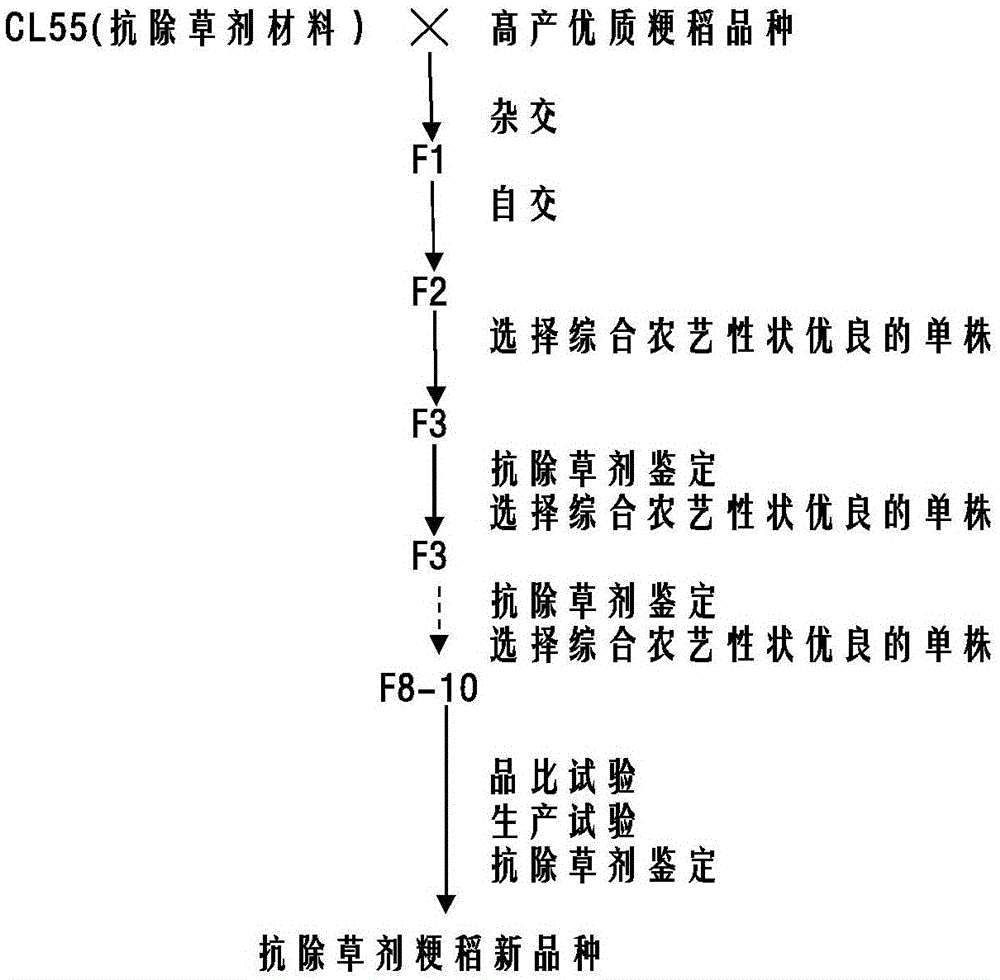Method used for breeding imidazolinone herbicide-resistant japonica rice
A technology for resistance to imidazolinone and herbicides, applied in the field of rice breeding, can solve the problems of poor comprehensive properties of materials, difficult to popularize and apply, shortening the time of materials, saving costs, and solving the problem of difficult prevention and control of weedy rice Effect
- Summary
- Abstract
- Description
- Claims
- Application Information
AI Technical Summary
Problems solved by technology
Method used
Image
Examples
Embodiment 1
[0032] Example 1 Obtaining the Japonica Rice Mutant "CL55" Resistant to Imidazolinone Herbicides
[0033] With reference to the method of Gu Jiaqing et al. (Gu Jiaqing et al., Shanghai Agricultural Journal, 2005, 21 (1): 7-11), 3000 seeds of Hudao No. 55 (crop selection of Shanghai Academy of Agricultural Sciences, passed Shanghai Variety Approval in 2011) Soak in distilled water for 24 hours. The temperature should not be too high to prevent germination. After draining the water, treat it with 0.6% EMS for 24 hours. During the treatment, keep stirring. The leaf stage was treated with the imidazolinone herbicide "Dou Xerox" water agent produced by Shandong Xianda Chemical Co., Ltd., and the treatment concentration was 8 g / mu. There was a phytotoxicity reaction 7 days after the spraying, and the seedlings' hearts and leaves began to turn yellow, most of them gradually rotted, and finally died. Two of them survived normally, and the seedlings were moved to the breeding field aft...
Embodiment 2
[0035] The experiment of the influence of the imidazolinone herbicides of embodiment 2 different concentrations on rice germination
[0036] Using "CL55" and its parent "Shangdao 55" as experimental materials, imidazolinone at different concentrations of 0.0%, 0.1%, 0.2%, 0.3%, 0.4%, 0.5%, 0.6%, 1.0% and 1.2% were studied. Effects of similar herbicides (volume ratio) on the germination rate of rice grains. The experiment was repeated 2 times. Select 100 full seeds of each material and put them into a petri dish covered with 2 layers of absorbent paper, add different concentrations of herbicides respectively, put them in a constant temperature incubator at 31°C, and count the seed germination after 5 days (Table 1) .
[0037] Table 1
[0038]
[0039]
[0040] The results showed that when the herbicide concentration started from 0.1%, the germination rate of herbicide-resistant and non-herbicide-resistant varieties began to differ. The herbicide variety "Hudao 55" did...
Embodiment 3
[0041] The influence experiment of the herbicide of embodiment 3 different concentrations and different treatment periods on rice growth
[0042] Using "CL55" and "Shanghai Rice 55" as test materials, different concentrations of herbicides (40 g / mu, 60 g / mu, 80 g / mu, prepared in 30 kg of water) and different treatment periods (1 leaf 1 core, 2 leaves 1 core, 3 leaves 1 core) on rice growth. After soaking the seeds of the two test materials to accelerate germination, select the germinated seeds that have sprouted neatly and sow them evenly. The area of the plot is 1.5m 2 . Choose a sunny day, and spray different concentrations of herbicides evenly on the surface of 1 leaf with 1 core, 2 leaves with 1 core, and 3 leaves with 1 core. After 2 days, start investigating the plant damage and dead seedlings. The results are shown in Table 2 below. Different concentrations of herbicides Effects of pesticides and different treatment periods on rice growth.
[0043] Table 2
[0044...
PUM
 Login to View More
Login to View More Abstract
Description
Claims
Application Information
 Login to View More
Login to View More - R&D
- Intellectual Property
- Life Sciences
- Materials
- Tech Scout
- Unparalleled Data Quality
- Higher Quality Content
- 60% Fewer Hallucinations
Browse by: Latest US Patents, China's latest patents, Technical Efficacy Thesaurus, Application Domain, Technology Topic, Popular Technical Reports.
© 2025 PatSnap. All rights reserved.Legal|Privacy policy|Modern Slavery Act Transparency Statement|Sitemap|About US| Contact US: help@patsnap.com



